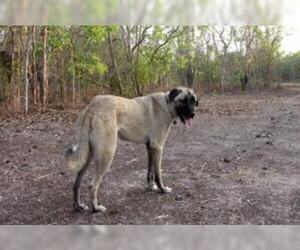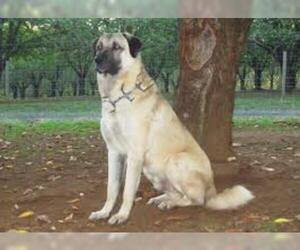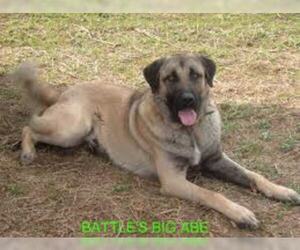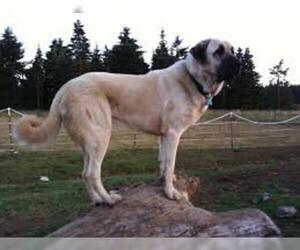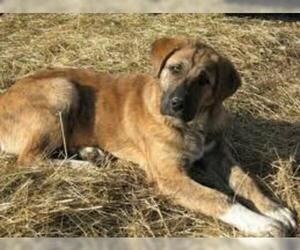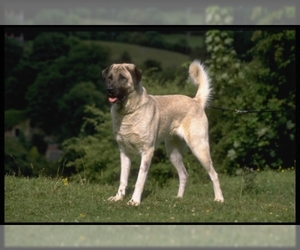
All about Anatolian Shepherd dog breed
A.K.A. :Çoban Köpeği, Kangal, Kangal Shepherd Dog, Karabash, Karabaş, Anatolian Karabash, Anatolian Kangal, Turkish Shepherd Dog, Anatolian dog, AS, ASD
Size
Grooming requirements
Exercise requirements
Good with other dogs
Watchdog ability
Energetic
Training requirements
Playful
Affectionate
Good with other pets
Good with children
Good with strangers
Winter
Summer
Healthiness
Protective
Life Span
| Pure Breeds | Member |
| Breeds A - Z | A |
| Breeds by Group | Flock Guards & Mastiffs Working |
| Breeds by Trait | Good With Kids High Stamina Dog Breeds |
| Overview: | The Anatolian Shepherd, an ancient and noble breed, hails from the rugged plains of Anatolia (modern-day Turkey), where they served as formidable guardians of livestock for thousands of years. These impressive dogs are renowned for their substantial size, typically weighing between 80-150 pounds and standing 27-29 inches tall, boasting a dense double coat that can range in color but is often fawn with a black mask. Their independent and intelligent nature makes them exceptional working dogs, displaying a strong protective instinct balanced with a calm demeanor. While fiercely loyal to their families, their guardian roots mean they are not ideal for apartment living; they thrive in homes with ample space and a job to do, making them unsuitable for inexperienced owners. With proper socialization and training, they can be wonderful companions, though their watchful nature means they often bond more closely with one or two family members. Generally a robust breed, potential health concerns include hip and elbow dysplasia, and bloat. |
F.A.Q.
All You Need to Know About the Anatolian Shepherd Breed
The Anatolian Shepherd is a majestic and ancient breed, originating from the Anatolian plains of Turkey where they were formidable livestock guardians. These dogs are renowned for their impressive size, typically weighing between 80-150 pounds, with a short to medium double coat that comes in various colors, often fawn with a black mask. Temperament-wise, they are calm, intelligent, and fiercely loyal to their families, but can be independent and reserved with strangers. While not ideal for apartment living due to their size and need for space, they make excellent family protectors in homes with secure yards and experienced owners. Their exercise needs are moderate, enjoying daily walks and patrolling their territory. Grooming is relatively low-maintenance, requiring regular brushing to manage shedding. Health-wise, they are generally robust but can be prone to hip and elbow dysplasia and bloat. Proper training and socialization from an early age are crucial for a well-adjusted Anatolian Shepherd.Anatolian Shepherd Weight: Average Size & Healthy Weight Range
The average weight for an adult Anatolian Shepherd is approximately 120-140 pounds. This majestic breed exhibits a significant size difference between sexes:- Males: Typically weigh between 110-150 pounds.
- Females: Generally range from 80-120 pounds.
Wondering about the Anatolian Shepherd height? These majestic guardians are impressively tall! The average size for an adult Anatolian Shepherd, measured at the shoulder, typically falls between 27 to 32 inches. This range gives you a good idea of how tall is a Anatolian Shepherd.
It's worth noting that there can be some variation based on gender and individual genetics. Generally, male Anatolian Shepherds tend to be on the taller end of the spectrum, often reaching 29-32 inches. Female Anatolian Shepherds are usually slightly shorter, typically ranging from 27-29 inches. However, individual dogs may fall outside these exact averages. When considering an Anatolian Shepherd, expect a truly imposing and statuesque companion!Anatolian Shepherd Colors & Coat TypesThe magnificent Anatolian Shepherd breed showcases a variety of coat colors. When considering an Anatolian Shepherd, understanding the AKC recognized Anatolian Shepherd colors is crucial for show prospects, while rare coat types and exotic Anatolian Shepherd variations might appeal to those seeking unique appearances.Officially, the American Kennel Club (AKC) accepts all colors and markings for the Anatolian Shepherd, emphasizing that coat color is secondary to the dog's overall type and soundness. This means a wide spectrum of colors is generally accepted. Common and recognized Anatolian Shepherd colors include:* Fawn: This is a very popular and widely recognized color, ranging from light to dark fawn.* Brindle: Characterized by stripes of darker color over a lighter base, often fawn.* Sesame: A mix of fawn and black hairs, giving a grizzled appearance.* Pied: Patches of color (often fawn or brindle) on a white base.* White: Can range from pure white to off-white or cream, often with "biscuit" markings (light fawn patches).* Cream: A softer, lighter shade than fawn.* Mahogany: A rich, reddish-brown color.* Reverse Brindle: Lighter stripes on a darker background.While the AKC is inclusive, certain colors are rarer or are considered exotic Anatolian Shepherd variations and may not be actively bred for or found in all pedigrees. These might include:* Black: While not explicitly disallowed, an all-black Anatolian Shepherd is less common than other colors.* Blue (Dilute Black): A very rare and sometimes controversial dilute color in many breeds, not traditionally associated with the Anatolian.* Lilac (Dilute Chocolate): Another very rare dilute color, unlikely to be seen in purebred Anatolian Shepherds from established lines.* Merle: This is a genetic pattern that creates mottled patches of color. Merle is not a recognized or natural color pattern for the Anatolian Shepherd breed and is highly indicative of cross-breeding with another merle-carrying breed. Breeders offering "merle Anatolians" are typically selling mixed-breed dogs.* Chocolate/Liver: Similar to blue and lilac, these dilute genes are not part of the Anatolian Shepherd's traditional genetic makeup and are extremely rare, if not impossible, in purebred lines.When researching Anatolian Shepherd colors and pricing, understand that rare or "exotic" colors like blue, lilac, or merle are not accepted by reputable breed clubs as purebred Anatolian Shepherd colors and should be viewed with caution. Focus on healthy, well-tempered dogs with excellent lineage, regardless of their specific coat color, as all officially recognized colors are equally valued by the AKC.
The Anatolian Shepherd personality is defined by a powerful blend of independence and loyalty. Originally bred as livestock guardians, their temperament of Anatolian Shepherd reflects this protective heritage. They are incredibly loyal to their families, often forming deep bonds. However, they are not typically effusive in their affection; their devotion is demonstrated through their vigilant nature.They are generally not overtly friendly with strangers, often appearing reserved or aloof, which is a key trait of a guardian breed. Early and consistent socialization is crucial to ensure they are sociable and well-adjusted. While intelligent, their independent nature means they require a confident and consistent owner.Adaptability to apartment living is very low. Anatolian Shepherds need ample space to roam and a job to do. They thrive in environments where they can patrol a large yard or property.With children, they can be gentle and protective, especially with "their" children, but their large size and strength necessitate supervision. They may not be suitable for homes with very young children who are not familiar with large dogs. Their guardian instincts can extend to other pets, but they may view strange animals as intruders. Proper introductions and consistent supervision are vital, especially with smaller pets they might perceive as prey.In summary, the Anatolian Shepherd is a noble, independent, and fiercely loyal protector, best suited for experienced owners in rural or spacious environments who understand and appreciate their unique guardian temperament.
Anatolian Shepherd Temperament: A Loyal and Protective CompanionThe Anatolian Shepherd temperament is characterized by a strong sense of loyalty, independence, and protectiveness. They are naturally watchful guardians, originally bred to protect livestock, and this instinct remains strong. When it comes to friendliness, Anatolians are typically reserved with strangers, evaluating new people carefully rather than being immediately effusive. Their sociability extends primarily to their family, whom they are deeply devoted to. Once they accept you as part of their "flock," their loyalty is unwavering.Due to their large size and need for space, adaptability to apartment living is very low; they require a large yard or acreage to thrive. Their behavior with children they know and are raised with is generally gentle and protective, viewing them as part of their family to be safeguarded. However, their size and guarding instincts mean supervision is always necessary, especially with unfamiliar children. Regarding other pets, they can coexist peacefully, especially if raised with them, but their strong prey drive can be an issue with smaller, unfamiliar animals. Early socialization is crucial.Anatolians can exhibit a degree of stubbornness, a trait stemming from their independent working heritage. They are intelligent but can be strong-willed, requiring consistent and patient training with a confident leader. They are not overly sensitive but respond best to fair and positive reinforcement rather than harsh methods. Overall, the Anatolian Shepherd is a noble, dedicated, and courageous companion dog for the right owner who understands and respects their unique disposition and needs.
Anatolian Shepherd Care: Essential Daily Maintenance for a Healthy & Happy CompanionAnatolian Shepherd care is relatively straightforward for this majestic breed. Despite their size, they are a low-energy dog breed indoors, though they need ample outdoor space for exercise.Grooming Needs: Anatolian Shepherds have a thick, double coat requiring weekly brushing to manage shedding, which intensifies during seasonal changes. While generally clean, occasional bathing is necessary, especially if they've been working or playing outdoors.Exercise Limitations: While they are not hyperactive, how to care for an Anatolian Shepherd includes ensuring they receive at least an hour of moderate exercise daily. This could be a long walk, playtime in a securely fenced yard, or opportunities to patrol their territory.Dietary Considerations: Feed a high-quality, large-breed dog food appropriate for their life stage. Monitor their food intake and weight closely to prevent obesity, a common issue in larger, less active breeds. Fresh water should always be available.Wrinkle and Ear Cleaning: Unlike some breeds, Anatolian Shepherds do not have prominent skin folds or wrinkles that require special cleaning. Their ears should be checked weekly for dirt, debris, or signs of infection and cleaned with a veterinarian-approved solution as needed.Climate Sensitivity: Anatolians are well-suited to various climates due to their dense coat, but they can be sensitive to extreme heat. Ensure they have access to shade and fresh water during warm weather. They are not brachycephalic, so breathing issues related to that anatomy are not a concern.Common Health Concerns & Health Tips for Anatolian Shepherd:* Skin Issues: While generally robust, some Anatolians can experience allergies or hot spots. Regular grooming helps monitor skin health.* Dental Care: Daily teeth brushing is ideal, or at least several times a week, to prevent dental disease. Dental chews and professional cleanings can supplement home care.* Weight Management: Due to their lower energy levels, weight management is crucial. Overweight dogs are prone to joint problems and other health issues. Consult your vet for dietary advice.* Joint Health: As a large breed, they are susceptible to hip and elbow dysplasia. Maintaining a healthy weight and providing appropriate exercise can help.Providing consistent daily maintenance and preventative care will ensure your Anatolian Shepherd thrives as a loyal and beloved member of your family.
Anatolian Shepherd Activity Level: Understanding Their Exercise NeedsThe Anatolian Shepherd activity level is generally moderate, blending impressive bursts of energy with a strong natural inclination for resting and observing. While not a hyperactive breed, they are far from sedentary and require consistent, appropriate exercise to maintain their health and well-being.Typical Energy Levels & Daily Exercise Needs: Anatolian Shepherds typically exhibit a calm demeanor indoors, but possess a surprising amount of stamina for their size. They are bred for guarding livestock over vast territories, meaning they are capable of sustained, lower-intensity movement rather than intense, prolonged bursts. Daily exercise needs include at least 45-60 minutes of moderate activity. This can be fulfilled through a long, brisk walk, off-leash exploration in a secure, fenced area, or a controlled hike. How active are Anatolian Shepherds? They thrive on having a "job" or purpose, even if it's just patrolling their yard.Playtime Preferences: While they enjoy playtime, their preferences lean towards more independent or low-key interactions. They aren't typically "fetch fanatics" who will play for hours. They enjoy sniffing, exploring, and engaging in short bursts of play with their family, often involving a sturdy chew toy or a gentle tug-of-war. They balance these short bursts of energy with long periods of rest, observing their surroundings with a watchful eye.Limitations & Brachycephalic Anatomy: It's important to note that Anatolian Shepherds are not brachycephalic. They possess a strong, well-proportioned muzzle, which means they do not suffer from the breathing difficulties often associated with brachycephalic breeds. This allows them to tolerate exercise in a wider range of temperatures compared to true brachycephalic dogs, though common sense precautions against overheating in extreme heat should always be observed due to their thick double coat.Suitability for Families: Are Anatolian Shepherds suitable for active families or low-energy households? They are best suited for moderately active families who understand and respect their independent nature and exercise requirements. While they enjoy their family, they are not typically "velcro dogs" that constantly demand attention. They can adapt to a slightly less active lifestyle if given consistent opportunities for mental stimulation and a secure outdoor space to patrol. However, they are not ideal for purely low-energy households that cannot commit to their daily exercise and mental stimulation needs, as boredom can lead to undesirable behaviors. Owners should be prepared for their strong guarding instincts and ensure proper socialization and training from a young age.
Breed Breakdown: What Experts Say About the Anatolian Shepherd
I would rate the "Size" trait of the Anatolian Shepherd breed a 9 out of 10.Anatolian Shepherds are undeniably very large dogs. Males typically stand between 29 and 32 inches tall and weigh 110 to 150 pounds, while females are slightly smaller at 27 to 30 inches and 80 to 120 pounds. Their body structure is robust and powerfully built, reflecting their heritage as livestock guardians. When compared to the vast majority of other companion dog breeds, their sheer scale is striking; they often tower over even other large breeds. Due to their immense size, they are absolutely not suited for apartment living or households with significant space constraints. Travel with an Anatolian Shepherd also presents considerable challenges, requiring large vehicles and ample space for them to be comfortable. They thrive in homes with large, securely fenced yards and ample outdoor space where they can move freely.
I would rate the Anatolian Shepherd's "Grooming Requirements" at a 4.While they possess a double coat that experiences seasonal shedding – sometimes quite heavily, warranting regular brushing during these periods – their overall grooming needs are relatively low-maintenance compared to many other breeds. Their coat is designed to be weather-resistant and doesn't typically mat or tangle easily, nor does it require professional stripping or elaborate styling. They don't have skin folds that necessitate frequent cleaning, and they are not particularly prone to common skin issues or allergies that demand specialized bathing or treatments. Routine nail trimming, occasional ear cleaning, and infrequent bathing when dirty are sufficient for their basic care. They are generally an easy-to-care-for breed in terms of grooming, requiring more attention during shedding seasons but not frequent, specialized grooming like many long-haired or thick-coated companion dogs.
I would rate the Anatolian Shepherd's "Exercise Requirements" a 6 out of 10.While not a breed that needs to run for miles every day, they definitely aren't couch potatoes and thrive with more than minimal activity. Their energy levels are moderate but sustained; they were bred to guard livestock over vast terrains, meaning they have good stamina for long, steady work rather than short bursts of intense speed. Daily, they require at least an hour to an hour and a half of purposeful activity, which can include a long walk, a hike, or extended playtime in a securely fenced yard. They are not brachycephalic, so they don't have respiratory limitations in that regard, though their large size means owners should be mindful of overheating in hot weather and avoid high-impact activities on developing joints. While not typically suited for high-level agility due to their sheer size and guarding instincts, they can enjoy training that involves problem-solving and moderate physical challenges. Structured routines are beneficial for both their physical health and mental stimulation, preventing boredom and potential destructive behaviors. They benefit from having a "job" to do, even if it's just patrolling their yard, and mental exercises are just as important as physical ones for this intelligent breed.
I'd rate the Anatolian Shepherd's watchdog ability as a 9.They are exceptionally vigilant and effective as household watchdogs, exhibiting a deep-seated territorial instinct that drives their protective nature. Their alertness to unfamiliar sounds and sights is remarkably high, and they possess a low tolerance for anything they perceive as a threat to their home or family. While not overly barky without reason, they will issue deep, resonant barks to announce the presence of strangers or perceived intruders, providing meaningful early warnings. This isn't a passive companion; their imposing presence, combined with their inherent courage and willingness to deter intruders, makes them a formidable and highly capable protector in a home environment. They are constantly aware of their surroundings and will make it clear when something is amiss.
I would rate the "Good with Other Dogs" trait of the Anatolian Shepherd a 4 out of 10.While not inherently aggressive, Anatolian Shepherds are primarily livestock guardians and possess a strong protective instinct and a naturally dominant temperament. This often translates to a need for careful management and significant socialization when it comes to other dogs. They are typically tolerant of dogs within their own "flock" (i.e., other dogs in their household with whom they have established a clear pecking order), but even then, their dominant nature can lead to friction, especially with dogs of similar sex or those challenging their perceived status. Around unfamiliar dogs, particularly those outside of a controlled environment, they can be highly suspicious and quick to assert dominance, which can be perceived as aggression. Their sheer size and power mean that even a "correction" can be serious. Compatibility with dogs of different sizes and energy levels depends heavily on the individual Anatolian and their early socialization, but generally, their lower play drive and watchful nature can make them less interested in playful interactions with high-energy dogs. Multi-dog households require very careful introductions, consistent training, and often separate spaces, as they thrive more as an independent guardian than a social playmate. While they *can* coexist peacefully with other dogs, it usually requires a dedicated owner who understands and manages their innate tendencies, rather than it being a natural, easy fit.
Rating: 4The Anatolian Shepherd is generally a laid-back and stoic breed, especially once past puppyhood. While they possess a deep well of endurance for their original purpose of guarding livestock over vast territories, their daily energy needs are not as high as many other working or sporting breeds. They thrive on having a job, even if that job is simply supervising their family or property, and prefer to observe rather than constantly engage in high-octane play.Their activity level is more about consistent, moderate exercise rather than intense bursts of energy. They enjoy a good long walk or the opportunity to patrol a securely fenced yard, but they are not typically dogs that will demand hours of fetch or high-impact athletic activities. Their playfulness tends to be more reserved and may involve a short wrestling match or a slow chase rather than a frantic romp. While capable of participating in outdoor activities, particularly those requiring stamina and a steady pace, they are not prone to being overly exuberant or constantly "on the go" compared to many other companion dogs.It's important to note that the brachycephalic anatomy is not a characteristic of the Anatolian Shepherd breed. Anatolian Shepherds have a normal, mesocephalic (medium-length) muzzle, which contributes to their excellent stamina and ability to breathe efficiently during sustained activity. Therefore, their breathing and exercise tolerance are not negatively impacted by brachycephaly; rather, their natural respiratory structure supports their enduring nature. Their energy is best described as a slow burn – always ready for action if needed, but content to conserve energy otherwise.
I would rate the "Training Requirements" of the Anatolian Shepherd at a 9. This breed is highly intelligent, but their independence and strong will make them incredibly demanding to train. They possess a natural guardian instinct, leading to a confident and often stubborn demeanor. Their attention span can be short if they perceive a task as uninteresting or unnecessary, and they are not inherently eager to please in the way many other breeds are. Responsiveness to commands requires immense consistency and patience; they will test boundaries repeatedly. While positive reinforcement is effective, it must be paired with firm, clear, and unwavering leadership. This is absolutely not a beginner-friendly breed and requires an experienced handler who understands canine psychology, can establish themselves as a confident leader, and is committed to a structured, lifelong training routine. Without consistent and knowledgeable guidance, an Anatolian Shepherd can quickly become unmanageable due to their size, strength, and strong protective instincts.
I would rate the Anatolian Shepherd's "Playful" trait a 3 out of 10.While they are intelligent and capable, Anatolian Shepherds are inherently working dogs bred for guarding livestock, and this purpose heavily influences their demeanor. They are generally very laid-back and serious compared to many other companion breeds. Their typical activity level revolves more around patrolling and observing rather than constant frolicking. They tend to have a lower drive for games and interaction for the sheer joy of it, preferring a more reserved presence. While they might engage in a short play session with a favorite person or a durable toy, their enthusiasm is usually measured rather than exuberant. Attention-seeking behavior is often subtle, perhaps a nudge or a quiet presence, rather than boisterous demands for play. Their daily life is characterized by a calm, watchful energy, not a naturally spirited or bouncy disposition.
I'd rate the "Affectionate" trait of the Anatolian Shepherd at a 6.Anatolians are profoundly loyal and form deep bonds with their families, demonstrating a strong desire for human companionship within their designated "flock." They are highly sensitive to owner emotions and will often follow family members around, acting as vigilant guardians. However, their affection is expressed differently than many companion breeds. They are not typically "cuddly" in the lap-sitting, constant physical closeness sense; their background as livestock guardians fostered independence and a more reserved demeanor. While they appreciate and expect their family's presence and will lean into gentle physical attention, they are generally not dogs that thrive on constant effusive displays of affection or seek to be smothered. Their love is a quiet, steadfast, and watchful devotion, more independent than a golden retriever, but certainly not emotionally distant. They appreciate respect and a calm, consistent relationship, rather than constant over-the-top effection.
I would rate the Anatolian Shepherd's "Good with Other Pets" trait a 6 out of 10.While Anatolian Shepherds are naturally protective and can be tolerant of animals they consider part of their "flock" (especially if raised with them), they are not inherently a highly pet-friendly breed in the same way some other breeds might be. Their strong prey drive, bred into them for livestock guarding, means that smaller, unfamiliar animals can easily be perceived as a threat or prey rather than a companion. They are also known for potential resource guarding, especially around food and their designated territory, which can cause friction with other dogs. Early and consistent socialization from a young age is absolutely crucial for them to learn to coexist peacefully with other pets, and even then, supervision is often necessary, particularly with new or smaller animals. They typically require a calm and confident owner who can establish clear boundaries and provide ongoing training to manage their natural instincts and ensure a harmonious multi-pet household. They are adaptable if raised in that environment but aren't naturally sociable with every animal they encounter.
Rating: 4The Anatolian Shepherd is not inherently "good with children" in the typical sense of a family pet. While they are incredibly loyal and protective of their own "flock," which includes their family, their temperament is more aligned with their role as a livestock guardian. This means they are independent, watchful, and can be reserved or even wary of strangers, including visiting children. Their immense size and strength, combined with a strong guarding instinct, mean that while they aren't naturally aggressive towards children, they require significant socialization from a very young age and constant, diligent supervision, especially with younger children or those unfamiliar with large, powerful dogs. They are not naturally playful in the way many breeds are and their patience for rough-and-tumble play or typical child antics can be low. They are also not particularly tolerant of noise or being handled roughly, which is common with children. They are not naturally gentle or overtly affectionate, preferring a more dignified interaction. For them to thrive in a family setting with children, extensive training for both the dog and the children, alongside rigorous supervision, is absolutely essential to prevent accidental injury or misunderstanding of the dog's boundaries and protective nature. They are better suited for homes with older, respectful children who understand how to interact appropriately with a large, guardian breed.
I would rate the Anatolian Shepherd's "Good with Strangers" trait as a 3.Anatolian Shepherds are inherently livestock guardians and, as such, are naturally reserved, watchful, and protective around unfamiliar individuals. Their primary instinct is to assess potential threats and keep their flock (or family) safe. While not typically aggressive without provocation, they are rarely overtly friendly or welcoming to strangers. They will often maintain a respectful distance, observing keenly, and may bark as a form of alert or warning. Early and extensive socialization is crucial to ensure they are tolerant of new people, but even with excellent training, they are unlikely to become a "meet-and-greet" type of dog. Their comfort in public or guest-filled environments usually stems from a quiet confidence that their human is in control, rather than an eagerness to interact with everyone. They require significant training and consistent exposure to new people to be *comfortable* with strangers, not naturally outgoing.
Rating: 9/10The Anatolian Shepherd boasts excellent cold-weather resilience, earning a high rating for its "winter" tolerance. Their dense, double coat, consisting of a thick undercoat and a coarser outer coat, provides superb insulation against cold temperatures. Their large size and substantial bone structure contribute to a lower surface area to volume ratio, which helps them retain body heat more efficiently. While not excessively fat, their lean muscle mass also aids in warmth. Crucially, they do not possess a brachycephalic anatomy, meaning their respiratory system is not compromised by cold air, reducing the risk of respiratory issues. These dogs are historically accustomed to harsh, cold climates in their native Anatolia, making them naturally robust in winter. The risk of hypothermia is relatively low for a healthy Anatolian Shepherd in typical cold weather, and they generally enjoy and thrive during outdoor activity in cold climates, often showing more energy in cooler temperatures.Compared to many other companion dogs, the Anatolian Shepherd requires minimal special care during winter months beyond providing adequate shelter from wind and snow, and ensuring access to fresh, unfrozen water. They do not typically need sweaters or booties, and their outdoor exercise routine can generally continue as usual, perhaps even with increased vigor. However, as with any dog, prolonged exposure to extreme blizzards or sub-zero temperatures without proper shelter should always be avoided.
I would rate the Anatolian Shepherd's "Summer" tolerance at a 7.While not brachycephalic and possessing a strong working dog lineage, which often correlates with a degree of environmental resilience, Anatolian Shepherds are large, double-coated dogs. Their thick undercoat, designed to protect them from both cold and heat in their native Anatolia, can become a liability in humid, stagnant heat. They are generally good at regulating body temperature when given access to shade and water, and their moderate activity levels in hot weather are usually self-regulated. However, their size means they have a larger body mass to cool down, increasing their risk of heatstroke if overexerted or kept in direct sun without respite.Compared to many other companion dogs, Anatolian Shepherds *do* require special care in summer months. While they aren't as delicate as a Pug or Bulldog, they are not a breed you can leave out in the sun for extended periods on a hot day. They need constant access to shade, abundant fresh water, and ideally, a cool, indoor retreat during peak heat. Exercise should be limited to early mornings or late evenings, and high-intensity activities should be avoided altogether in sweltering conditions. Overweight individuals will be even more susceptible. So, while they are not extremely sensitive, their size and coat demand a mindful approach to summer management to prevent heat-related issues.
I would rate the Anatolian Shepherd's "Healthiness" trait as an 8 out of 10.Anatolian Shepherds are generally considered a remarkably robust and healthy breed, particularly when compared to many other large and giant dog breeds. They boast a relatively long life expectancy for their size, often living 11 to 13 years, with some reaching even older ages. Their ancient lineage as working dogs has fostered a natural resilience and hardiness. While not entirely immune to health issues, they are less prone to the severe breathing difficulties, extensive skin conditions, or widespread genetic disorders that plague some other breeds.That being said, like most large breeds, they can be predisposed to certain orthopedic problems such as hip and elbow dysplasia. Bloat (gastric torsion) is also a concern due to their deep chests, and eye conditions like entropion or ectropion can occur. Responsible breeding practices, including health testing of parents for these orthopedic and eye conditions, significantly mitigate the risk of these issues in offspring. With proper nutrition, regular exercise, and preventative veterinary care, Anatolian Shepherds are generally considered to be a low-maintenance breed in terms of health compared to many other companion dogs. They are more generally robust than high-maintenance in this regard.
I would rate the "Protective" trait of the Anatolian Shepherd breed a 10.This breed is exceptionally protective, embodying the very definition of a guardian dog. Their protective nature stems from a deep-seated instinct to guard their flock, which, in a household setting, translates to their human family and territory. They are incredibly alert, constantly surveying their surroundings for anything out of the ordinary. Their territorial instincts are highly developed; they will readily perceive any unfamiliar presence as a potential threat to their domain. This manifests as a cautious and often formidable reaction to strangers, often involving a deep, resonant bark and a watchful, imposing stance. While immensely loyal and gentle with their owners and trusted family members, their demeanor can shift dramatically when they perceive a threat, displaying a calm yet unwavering determination to protect. They are far more than just companion dogs; they are profoundly capable of offering meaningful protection in a household setting, making them excellent watchdogs and true guard dogs for those who understand and can manage their formidable instincts.
I would rate the "Life Span" trait of the Anatolian Shepherd breed a 6 out of 10.Anatolian Shepherds are generally considered to have an average to slightly above-average lifespan compared to many other giant breeds, but still fall within the typical range for large and giant companion dogs, which tend to have shorter lifespans than smaller breeds. Their average life expectancy is typically 10 to 13 years, with many living into their early teens. While not exceptionally long-lived, this is commendable for a dog of their size. Common health issues, such as hip and elbow dysplasia, gastric torsion (bloat), and some eye conditions, can impact their longevity and quality of life if not managed. However, responsible breeding practices that screen for these genetic predispositions, combined with proper nutrition, exercise, and veterinary care, significantly contribute to a healthy and fulfilling lifespan for these dogs. They aren't prone to as many widespread, debilitating genetic conditions as some other giant breeds, which helps them achieve a respectable age.
Anatolian Shepherd Puppies for saleSee all puppies for sale
Anatolian Shepherd Dogs for adoptionSee all dogs for adoption
Anatolian Shepherd BreedersSee all breeders
Similar Dog Breeds for Anatolian Shepherd
Breed Mixes of Anatolian Shepherd
Quick Breed Selector 0 - not important, 1 - smallest, 10 - largest
Variants & Mistakes :Anatolian Shephard, Anatolion Shepherd, Anotolian Shepherd, Anatolian Schepherd, Anatolain Shepherd, Anatolian Shepard, Anatolian Sheperd, Anotolian Shephard, Anatolian Shespherd, Anatolain Shephard, Anatolian Shephered, Anatolien Shepherd, Anatolian Sherpherd, Anatolian Sheperhd, Anatoian Shepherd, Anatolina Shepherd, Anatolian Shepardd, Anatolian Sheperdess, Anatolian Shepherds, Anatolian Shepards, Anatolian Sheperds, Anatolian Shephardes, Anatolian Sheperhed, Anatolian Shephardd, Anatolian Shepherrd, Anatolian Shepheredd, Anatolian Shepherdd, Anatolain Sheperd, Anatolion Shephard, Anotolian Sheperd, Anatolian Schephard, Anatolian Scheperd, Anatolain Schepherd, Anatolion Schepherd, Anotolian Schepherd, Anatolian Shepord, Anatolian Shephord, Anatolian Shpherd, Anatolian Shephardess, Anatolian Sheperdes, Anatolian Shephards, Anatolian Shaperd, Anatolian Shapherd

